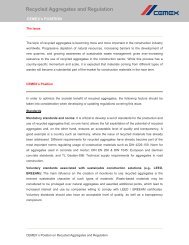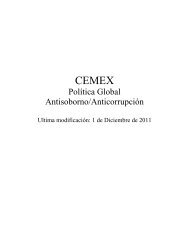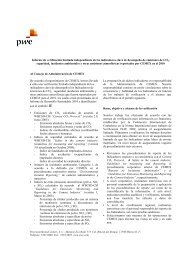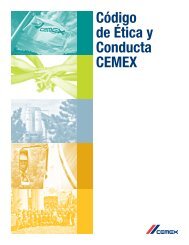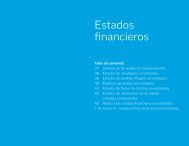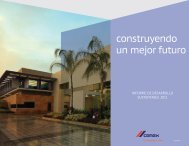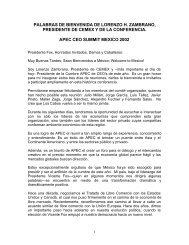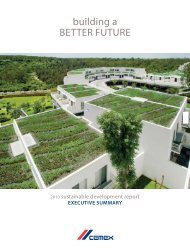building a STRONGER foundation - Cemex
building a STRONGER foundation - Cemex
building a STRONGER foundation - Cemex
Create successful ePaper yourself
Turn your PDF publications into a flip-book with our unique Google optimized e-Paper software.
CEMEX, S.A.B. DE C.V. AND SUBSIDIARIES<br />
Notes to the Consolidated Financial Statements – (Continued)<br />
As of December 31, 2010, 2009 and 2008<br />
(Millions of Mexican pesos)<br />
As a result of ASU 2009-16, beginning January 1, 2010, CEMEX’s accounts receivable sold under its securitization program in Mexico no<br />
longer qualify for derecognition under U.S. GAAP considering that despite the effective surrender of control associated with the trade<br />
receivables sold and that CEMEX does not guarantee or is obliged to reacquire the assets. CEMEX participates on a stand-alone basis in a<br />
securitization program in Mexico and retains certain administrative roles in connection with the collection of the accounts receivable.<br />
Consequently, the condensed balance sheet financial information under U.S. GAAP as of December 31, 2010 includes the reversal of the<br />
receivables sold and derecognized under MFRS for approximately Ps3,617, which were recognized as part of current assets against current<br />
liabilities. For the years ended December 31, 2010, 2009 and 2008, CEMEX considers there are no material effects that would require<br />
reconciling adjustments in the reconciliation of net income (loss) to U.S. GAAP since the discount granted to the acquirers of the trade<br />
receivables is recorded as financial expense under MFRS (note 5).<br />
(o) Other Disclosures under U.S. GAAP<br />
Asset retirement obligations and other environmental costs<br />
ASC 410, Asset Retirement and Environmental Obligations (“ASC 410”), requires entities to record the fair value of an asset retirement<br />
obligation as a liability in the period in which a legal or a constructive obligation is incurred associated with the retirement of tangible<br />
long-lived assets that result from the acquisition, construction, development, and/or normal use of the assets. Such liability would be<br />
recorded against an asset that is depreciated over the life of the long-lived asset. Subsequent to the initial measurement, the obligation will be<br />
adjusted at the end of each period to reflect the passage of time and changes in the estimated future cash flows underlying the obligation.<br />
MFRS C-9, Liabilities, Provisions, Contingent Assets and Liabilities and Commitments ("MFRS C-9"), establishes generally the same<br />
requirements as ASC 410 in connection with asset retirement obligations. For the years ended December 31, 2010, 2009 and 2008, CEMEX<br />
did not identify any differences between MFRS and U.S. GAAP in connection with this topic.<br />
In addition, environmental expenditures related to current operations are expensed or capitalized, as appropriate. Other than those<br />
contingencies disclosed in notes 13 and 20, CEMEX is not currently facing other material contingencies, which might result in the<br />
recognition of an environmental remediation liability.<br />
Accounting for Costs Associated with Exit or Disposal Activities<br />
CEMEX accrues the costs related to an exit or disposal activity, including severance payments, according to ASC 420, Exit or Disposal Cost<br />
Obligations (“ASC 420”), which basically requires, as a condition to accrue for such costs, that the entity communicate the plan to all affected<br />
employees and that the plan be terminated in the short-term; otherwise, associated costs should be expensed when incurred.<br />
Guarantor's Accounting and Disclosure Requirements for Guarantees<br />
Under U.S. GAAP, a guarantor is required to recognize, at origination of a guarantee, a liability for the fair value of the obligation<br />
undertaken. As of December 31, 2010 and 2009, CEMEX has not guaranteed any third parties' obligations. Nonetheless, with respect to the<br />
electricity supply long-term contract in Mexico discussed in note 19C, CEMEX may also be required to purchase the power plant upon the<br />
occurrence of specified material defaults or events, such as failure to purchase the energy and pay when due, bankruptcy or insolvency, and<br />
revocation of permits necessary to operate the facility. For the years ended December 31, 2010, 2009 and 2008, for accounting purposes<br />
under MFRS and U.S. GAAP, CEMEX has considered this agreement as a long-term energy supply agreement for own use and no liability<br />
has been created, based on the contingent characteristics of CEMEX's obligation and given that, absent a default under the agreement,<br />
CEMEX's obligations are limited to the purchase of energy from, and the supply of fuel to, the plant.<br />
Variable Interest Entities<br />
The FASB issued ASU 2009-17, Consolidations (Topic 810): Improvements to Financial Reporting by Enterprises Involved with Variable<br />
Interest Entities (FASB Statement No. 167, Amendments to FASB Interpretation No. 46(R)) (“ASU 2009-17”) in December 2009. ASU 2009-<br />
17, which amends the Variable Interest Entity (VIE) Subsections of ASC Subtopic 810 10, Consolidation – Overall, revises the test for<br />
determining the primary beneficiary of a VIE from a primarily quantitative risks and rewards calculation based on the VIE’s expected losses<br />
and expected residual returns to a primarily qualitative analysis based on identifying the party or related party group (if any) with (a) the<br />
power to direct the activities that most significantly impact the VIE’s economic performance and (b) the obligation to absorb losses of, or the<br />
right to receive benefits from, the VIE that could potentially be significant to the VIE. ASU 2009-17 requires kick out rights and participating<br />
rights to be ignored in evaluating whether a variable interest holder meets the power criterion unless those rights are unilaterally exercisable<br />
by a single party or related party group. ASU 2009-17 also revises the criteria for determining whether fees paid by an entity to a decision<br />
maker or another service provider are a variable interest in the entity and revises the Topic 810 scope characteristic that identifies an entity as<br />
a VIE if the equity at risk investors as a group do not have the right to control the entity through their equity interests to address the impact of<br />
kick out rights and participating rights on the analysis. Finally, ASU 2009-17 adds a new requirement to reconsider whether an entity is a VIE<br />
if the holders of the equity investment at risk as a group lose the power, through the rights of those interests, to direct the activities that most<br />
significantly impact the VIE’s economic performance, and requires a company to reassess on an ongoing basis whether it is deemed to be the<br />
primary beneficiary of a VIE. ASU 2009-17 is effective for CEMEX beginning January 1, 2010. The adoption of ASU 2009-17 did not have<br />
a material impact on our consolidated financial statements.<br />
F-78



